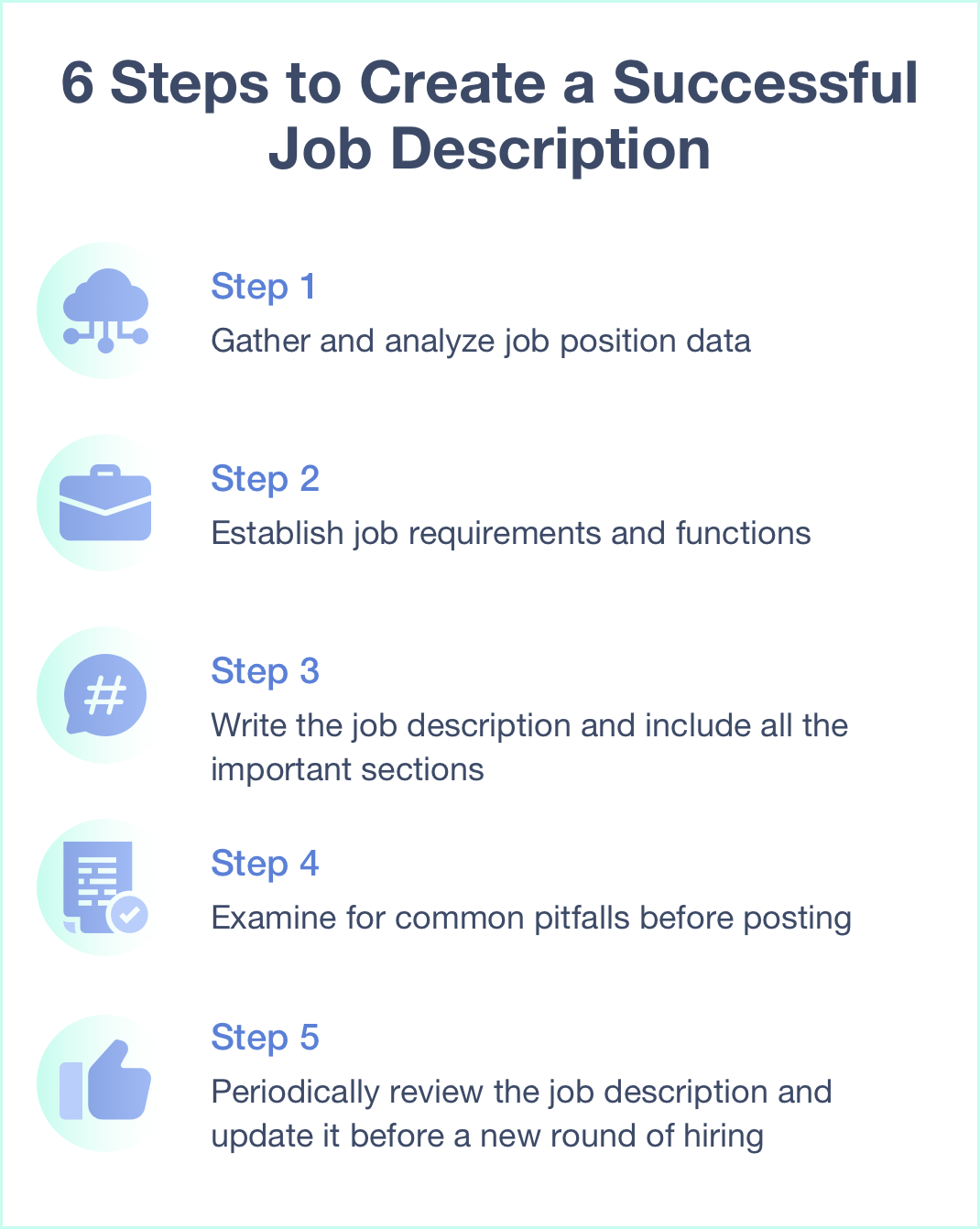Putting together a clear, thorough, and well-developed job description takes time and effort. In fact, many organizations fail to recognize just how a job description is different from an ad/posting and how valuable effective job descriptions are. And many companies don’t put in the work necessary to create them.
Let’s take a look at why job descriptions are so important during hiring campaigns and throughout an employee’s career, as well as how to develop them.
What makes job descriptions an essential part of hiring?
What is a job description, and why is it so important in hiring? A job description serves as an overview of the tasks, responsibilities, and requirements for a particular role at your organization. That sounds simple enough, but when you know how to write a good job description, it doesn’t just help you find applicants and prevent bad hires. A strong, well-written job description actually helps you throughout the employment life cycle of any position at your business.
Here’s how an effective job description can help you in each of the following phases:
- Hiring. A clear, accurate and enticing description helps attract qualified candidates and encourages them to apply for the position.
- Onboarding. By using the description — including job tasks — when planning onboarding and training, you’ll ensure that your new employee is given a solid foundation to start off well.
- Performance evaluations. Having the requirements and goals for the job in front of you during evaluations will help you focus on how well the employee meets expectations, as well as where additional training may be helpful.
- Development & training. If you’ve determined areas where the employee would benefit from additional training, you can plan and focus instruction on those topics.
- Retention. Focusing on the success of your employees helps demonstrate that you want to keep them and makes them less likely to leave, so be sure to discuss the person’s future with your company and how they can gain skills for possible promotions down the road.
Are job descriptions different from postings?
Job postings are primarily used to help advertise a position and find candidates for a particular role. These job listings or ads often appear in print and/or online job sites, websites and social platforms. Job postings include a job title and information about duties, tasks, reporting hierarchy, benefits, etc., but they aren’t as detailed or extensive as job descriptions, which are more in-depth and more widely used by your internal team.

5 steps to create a successful job description
Knowing how to develop a job description may seem a bit overwhelming at first, but if you break the process down into five manageable steps, you’ll find it much easier. Plus, the more time you spend analyzing and determining the tasks, necessary traits, requirements, and expectations for a particular position, the more likely you are to create a job description that attracts top talent and helps you succeed in hiring the right people for the job.
Step 1: Gather and analyze job position data
The first step in knowing how to develop a job description is understanding the job itself. You’ll start by gathering and analyzing information in a job position analysis. A job analysis helps you examine a particular job at your organization and determine what’s needed for success in that role. For instance, what skills and abilities are necessary? Which personality traits are useful, helpful, or truly essential? What type of work environment will the person have or need to be comfortable in?
To answer these questions, start by talking to people in the same or similar jobs, as well as people who will work with and manage the employee. Someone who’s done well in a similar job can provide you with details about the skills and traits they feel are critical for success in that role. If a manager says that proficiency in a particular software program is important, that should be included when you develop a job description.
When putting together your list of skills, don’t forget to include “soft skills” and character traits that are important for the job. Having the right personality traits can be even more important than knowledge: Some skills can be learned through on-the-job training, but you can’t teach someone to be warm and friendly or to be a good team player.
For example, if you’re hiring a front desk receptionist, you’ll likely want someone who is outgoing and comfortable welcoming visitors to your company. If you’re seeking an accountant, you’ll want someone who’s not only proficient in Excel but also detail-oriented.
If you’re using an online hiring system, you can collect information about skills and traits and begin to create a baseline for the job. A baseline is an outline of your ideal candidate, including all the personality traits you’re looking for. It serves as a benchmark during the hiring process, helps you know what to include in the job description, and allows you to quickly rule out candidates who aren’t right for the job, as well as select the applicants who are.
But how will you know if a candidate really has all the skills and personality traits you need? That’s where pre-employment testing comes in. Pre-employment testing offers you a chance to evaluate personality traits and check for skill level and ability through aptitude testing, saving you from wasting time on unqualified candidates, and providing an objective way to narrow your list prior to the interview process.
Step 2: Establish job requirements and functions
The next step in creating a job description is to outline job duties and responsibilities. For example, be clear about whether the person will work primarily solo or as a member of a team. Other information to detail includes the following:
- What will daily tasks look like? Will there be a great variety of work tasks or more of a routine?
- What kind of schedule will the employee have? Will hours be flexible or strict?
- Where will the person work? Will they have an office or designated workspace? Will locations vary? Will travel be required?
- To whom will the person report, and to whom should questions or concerns be addressed? Will the employee manage others?
- What are the essential functions the person will be responsible for on a daily, weekly, and monthly basis? How will tasks be acknowledged, recorded, tracked, and approved?
Say goodbye to guesswork, hire with confidence
Try our platform for free and get unbiased, data-driven insights into candidates' personal qualities and abilities.
Book a Demo Try It FreeStep 3: Write the job description and include all the important sections
In the third step of writing your job descriptions, you’ll organize all the data you’ve collected and start writing out the job description. It’s important to be transparent about not only the skills and traits necessary for success but also daily tasks, responsibilities, work environment, reporting structure, and expectations. It’s also a good idea to explain how this job fits into the mission and goals of your organization.
Your job analysis will serve as the foundation for what to include in the job description. Be sure to include the personality traits and skills necessary for the job.
An effective job description includes many of the same things as a posting, but should be more detailed, since they’ll ideally be used by other members of your team in evaluations and throughout an employee’s career. You should always include the following sections when you build a job description:
- Job title. Your title should be clear and specific; resist the temptation to make the title sound trendy if that will only confuse people.
- Job summary. The summary is an overview that helps explain why the role exists, how it fits into a team or department, and what a top candidate will bring to the role.
- Responsibilities. Here, you’ll outline the primary duties of the job and what the person will do, as well as the location for the job, whom they’ll report to, if that employee will manage others, and whether travel is required.
- Requirements. The requirements list should include the experience, education, skills, and qualities that are critical for success in the role, as well as any preferred abilities and traits listed in your baseline.
- Salary & benefits. IThis information is especially important for a job posting, but it’s also important to include a salary range and benefits so employees and colleagues know what to expect and how a strong performance could lead to additional compensation.
- Testing. If pre-employment tests are part of your hiring plan for the role, include information about which tests will be given prior to interviews.
- About. Here, it’s a good idea to include information about how the role fits into the overall goals and mission of the organization.
Step 4: Examine for common pitfalls before sharing
There are a number of common mistakes to avoid when you create a job description. First, job descriptions are often too vague or lack metrics that support the job requirements. Clarity and transparency are key in understanding how to develop a job description. Don’t leave out details about responsibilities that could cause confusion later on.
Also when thinking about what to include in a job description, don’t forget to explain how the job fits into the company and into a particular department. Candidates and employees want to understand how they’re contributing to the overall success of the organization and why their work matters. By sharing this information, you can also demonstrate a potential career path with your team.
Step 5: Periodically review the job description and update it before a new round of hiring
You’ll want to review the job description (and your associated baseline) for each role at your organization regularly to ensure that the tasks, responsibilities, skills, and personality traits are accurate and up to date.
One good time to review job descriptions is during evaluations. Talk with managers and your employee about the description and whether they feel there are important abilities or traits missing from the list of tasks and skills. Job responsibilities can change over time, and you’ll want to accurately reflect the position when writing job descriptions.
Another good time to refine baselines is when an employee leaves or is promoted at your organization. Holding an exit interview — even if the employee is staying with your company to take on a new role — provides a great opportunity to find out more about which capabilities are really critical.
Of course, if you’re hiring a new or additional employee for the same role, you’ll want to review the description prior to advertising the opening. If you’re using an online hiring system, you can quickly refer to your baseline and make adjustments if needed. If additional skills or personality traits have been identified as being important, you can add those to the job description and posting and make adjustments to your pre-employment testing plan.
Integrate job description development into your hiring process
Writing job descriptions is an involved process, but when you spend time in the beginning to do it right, both you and your employee will benefit. A clear, well-written description will serve you well throughout an employee’s career. And when you select an online system like Hire Success® to help you, you’ll find that your entire hiring process will be faster and easier — you’ll cut business costs, create better job descriptions and ads, conduct better interviews, and make quicker, more confident decisions.


